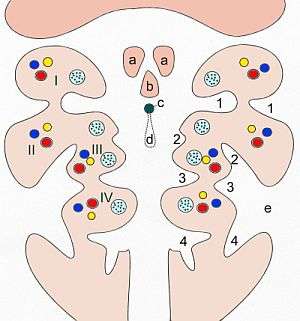Cervical sinus
| Cervical sinus | |
|---|---|
 Pattern of the branchial arches. I-IV branchial arches, 1-4 branchial pouches (inside) and/or pharyngeal grooves (outside) a Tuberculum laterale b Tuberculum impar c Foramen cecum d Ductus thyreoglossus e Sinus cervicalis | |
| Details | |
| Latin | sinus cervicalis |
During Human embryogenesis the mandibular arch and hyoid arch grow more rapidly than those behind them, with the result that the latter become, to a certain extent, telescoped within the former, and a deep depression, the cervical sinus, is formed on either side of the neck.
This sinus is bounded in front by the hyoid arch, and behind by the thoracic wall; it is ultimately obliterated by the fusion of its walls.
Formed by the walls of the 2-4th pharyngeal grooves merging. Sometimes it can remain anterior to the sternocleidomastoid muscle. It can communicate with the skin( external cervical fistula) or with the pharynx ( internal cervical fistuala). Prone to infection.
Additional images
-

The head and neck of a human embryo thirty-two days old, seen from the ventral surface.
References
This article incorporates text in the public domain from the 20th edition of Gray's Anatomy (1918)
External links
- hednk-022—Embryo Images at University of North Carolina